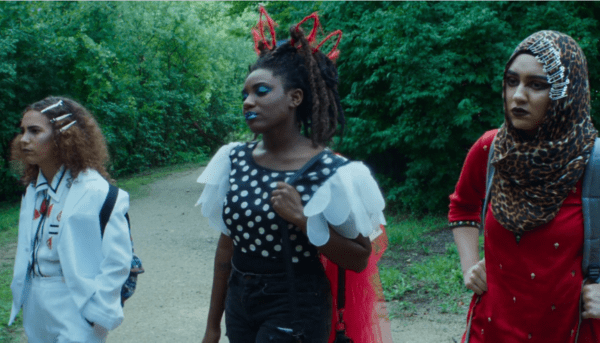Film Review: “Knives and Skin” — Sensual, Surreal, Stunning
By Peg Aloi
Though the story’s events are set in the present, the Gen X music feels right, coming as it does from an era when fear, decadence, and moral hypocrisy also dominated our culture.
Knives and Skin, directed by Jennifer Reeder. Screening at the Brattle Theatre, Cambridge, MA, tonight through December 11.

A scene from the sensually surreal “Knives and Skin.”
Filmmaker Jennifer Reeder’s stylish debut Knives and Skin is part weird thriller, part sensual coming of age story. As I watched, I found myself noticing what seemed to me clear homages to myriad films and visual artists, yet I was also struck by the daring originality of this film’s look, feel, and story.
The opening scene is strange indeed: there is a close-up of a woman’s eyes, and she looks haunted and anxious. The camera pulls back to show Lisa (Marika Engelhardt) standing in her kitchen, a colorfully lit space with tiny lights and a bright pink shadow. Lisa is wearing a white lace dress and holding a knife, looking like a character Sherri Moon Zombie might play in one of her husband’s colorful films. Lisa goes to her daughter Carolyn’s bedroom door, whispering her name. After she gets no response, Lisa uses the knife to pick the lock on the door.
After looking around in Carolyn’s room, her mother picks up a dark green sequined dress and holds it up to her chest: now she looks like the woman featured in Kenneth Anger’s Puce Moment. Speaking of Anger, other visual homages to the director show up later, with a camera closely lingering on a tray of silver jewelry and perfume.
We then see 15-year-old Carolyn (Raven Whitley) with a boy in his car arrive at the local make-out spot, she in a marching band uniform and he in a varsity football jacket. The two walk toward the water and start to make out, Carolyn confidently taking the lead. She bites him on the forehead and the wound glows, as if she has left some kind of phosphorescence behind. This is the second moment (the first being Lisa’s odd behavior with the knife) where we wonder if this is a horror film. But Knives and Skin ultimately ventures beyond simple genre tropes and gamely inverts and shatters them.
Adolescent sexuality is at the story’s thematic heart. Andy (Ty Olwin) pressures Carolyn to go a bit further than she wants, and when she says she’s changed her mind and wants to go home, he calls her a slut and leaves her there. He drives off with her glasses (which also glow brightly) and, unable to see clearly, Carolyn stumbles and falls. Then she vanishes. In the wake of her disappearance, we meet a number of her fellow students and friends, all grappling with her disappearance, but also dealing with various family, school, and social challenges.
The most prominent characters are Charlotte (Ireon Roach), a budding performance artist who dresses in outrageous outfits and tutors a smitten football player; Laurel (Kayla Carter), a cheerleader who is also dating Andy but is drawn to a female classmate; and Andy’s sister, Joanna (Grace Smith), a scrappy entrepreneur who sells her mother’s prescription drugs and makes iron-on shirts with the names of feminist icons like Angela Davis and Joan of Arc. The students’ parents are also dealing with demons: infidelity, mental illness, unemployment, and grief. The cast is uniformly excellent; and it’s refreshing to see a fairly intersectional depiction of high school where racial diversity, queer sexuality, and outcast status are depicted as the norm rather than the exception.
Like other borderline horror films that explore how the lives of high school students darkly mirror those of their parents and teachers (like Carrie, Blue Velvet, River’s Edge, Donnie Darko, The Virgin Suicides, The Sisterhood of Night, Assassination Nation, and others, all of which seem to have informed Reeder’s vision), Knives and Skin wants to take a dive into the cultural unconscious. It portrays an evocative, sensual world where the mundane is first interrupted by epiphanies and then amplified with cathartic passions. The film’s dreamy cinematography and intricate yet realistic production design, with fairy-like lighting in shades of pink and green, create a sort of otherworldly effect. It allows the characters to drift in and out of our consciousness as the narrative follows their converging movements.
Then there’s the music. Just as Donnie Darko (a 2001 film set in 1988) reimagined an iconic ’80s song, “Mad World,” with a slow, minimal piano accompaniment, Knives and Skin strips bare songs by ’80s artists such as The Go Gos, Cyndi Lauper, Naked Eyes, and New Order by having an all-female choir sing them a cappella. The choice is brilliant, beautiful, and devastating. Though the story’s events are set in the present, the Gen X music feels right, coming as it does from an era when fear, decadence, and moral hypocrisy also dominated our culture. The multiple plotlines can at times be distracting, but I enjoyed the film’s eclectic energy, which swirls throughout. Reeder’s style sometimes made me think of attention-deficit disorder — a malady discovered in the ’80s — and the way it bounces between frenetic bouts of chaos and hyper-focused acts of brilliant thought and creativity. Straddling both states of mind, Knives and Skin delivers beguiling, intense vignettes of movie magic.
Peg Aloi is a former film critic for The Boston Phoenix and member of the Boston Society of Film Critics. She taught film studies in Boston for over a decade. She writes on film, TV, and culture for web publications like Vice, Polygon, Bustle, Mic, The Orlando Weekly, Crooked Marquee, and Bloody Disgusting. Her blog “The Witching Hour” can be found at themediawitch.com.

